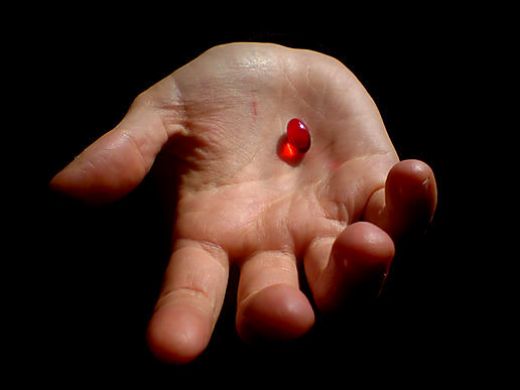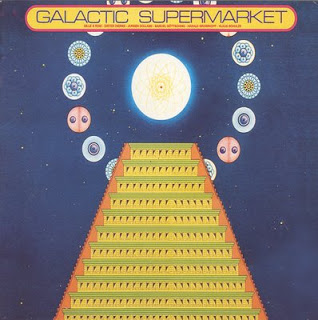
Take the Red Pill
You probably have seen the ads on TV: a cartoon thirty-something female, animated with bland, funny-pages strokes, mopes against a white background, her glasses pushed distractedly back on her head. “I can’t concentrate,” she complains. “I feel anxious.” “I’m so irritable.” The words materialize around her, heavy text that she throws onto a mounting pile of other phrases, like “out of control” and “slipping.” Meanwhile, the kind and understanding female voice-over informs us that if we have experienced “excessive worry” or similar symptoms for six months or more, we may be suffering from the same plaint that apparently troubles Ms. Cartoon: generalized anxiety disorder.
For viewers who find these symptoms all too familiar, this diagnosis might come as a relief. After all, once you’ve been diagnosed with a “disorder” there’s a good chance that the pharmaceutical cavalry is on its way. And indeed, according to the ad, Bristol-Myers Squibb’s non-habit-forming BuSpar may be just the ticket. Of course, we must face a raft of side effects, which the voice-over rattles off like the credits that race by the end of sitcoms: excitement, headache, nausea, dizziness, lightheadedness, and nervousness. Though you might think twice about taking a drug that replaces anxiety with nervousness, our bugged-out cartoon Cathy is clearly willing to risk the fallout. Fortified with BuSpar, she smiles confidently as she sweeps up the oppressive verbiage into a little wastebasket. “Worry” falls from the sky, and it lands neatly in her pocket. “Relax,” goes the tag line. “BuSpar can help you handle it.”
The first time I saw this ad, with its folksy appeal to push-button neural reprogramming, I felt as if I had momentarily slipped into a prequel to Brave New World as remixed by Phil Dick. A banal future-present shudder passed through me, something I have come to associate with phenomena I describe as “21C.” Most of the stuff we encounter these days remains pretty twentieth century, but “21C” phenomena are like animae cyborgs waltzing through your supermarket. Ten-year-olds with Gameboys in one hand and cell phones in the other are 21C. Breaking last year’s extreme weather records (and drooling over the resulting weather porn) is 21C. Tiger Woods — with his multiethnic, corporate persona, his rich-man’s game, and his preternatural mastery of fame — is 21C. Faster-than-light photons, cloned pets, Napster, and millionaire tourists on Mir are all very 21C. And so are mainstream cartoon TV ads for cosmetic psychopharmacology.
The stage for all this was set long ago. In the sixties, benzodiazepines like Valium were used to treat the anxiety and depression that bathed “normal” nuclear family life. Mother’s little helpers were not considered personality-modifiers — even though prolonged use often turned mother into a paranoid freak. But the mainstream acceptance of Valium and its brethren helped lay the groundwork for Prozac, the first full-bore anti-depressant to come out of hiding and change our minds about our minds. Taking the world by storm, Prozac spread the idea that seemingly normal people — with functioning but chronically unhappy temperaments — were actually suffering from systematic chemical imbalances that medicine could fix. Indeed, the posthuman self is a self on drugs — SSRIs, hormones, brain boosters, neurotransmitters.
On the biological level, all this is pretty good medicine. Scores and scores of people report that Prozac works for them, and in very manageable ways. But what does the drug itself have to say? Most psychoactive drugs have a truth or two to relate — indeed, we generally experience drugs in the context of the stories they tell. When the psychiatrist Peter Kramer listened to Prozac, what he heard was a story in which curing illness was only the beginning. More fundamentally, Prozac initiated a process that — amplified by postmodern social mores and the popularity of biological determinism — has come to reshape our experience of ourselves as selves. As the BuSpar ad shows, we have entered an era that sanctions the psychoactive use of commercial chemicals, not just to cure disease or even to relieve suffering, but to reformat who we feel we are.
Of course, humans have always used drugs and foods to modify their thoughts and moods. Today millions of people continue to consume nicotine, alcohol, and caffeine as blunt equivelents of Prozac or Xanax. (It goes without saying that the action of these drugs, whether BuSpar or coffee, varies radically depending on the shifting chemical composition of your brain, as well as other factors.) Nor is BuSpar itself particularly new. The compound busipirone has been easing worried minds since the mid-eighties, and it remains only one of a wide variety of time-honored drugs — including various azaspirones, benzodiazepines, beta blockers, and MAOIs — that are used to treat panic attacks, obsessive-compulsive behavior, and the nebulously defined generalized anxiety disorder. Like Prozac, busipirone has an affinity for serotonin receptors, although the exact mechanism of the drug remains unknown. Unlike the bennies Valium or Xanax, it’s nonaddictive, and apparently not particularly fun.
But BuSpar is not just the drug busipirone. BuSpar is a carefully marketed product, one being sold at a time when pharmaceutical corporations are bypassing the doctor and directly targeting the consumer with anticholesterol drugs and heartburn medications. Having already cornered the market on depression in the nineties, pharmacorps have clearly picked anxiety as the next psychological complaint to go after with their heavy (and heavily-marketed) guns. Besides ads for BuSpar, SmithKline Beecham Pharma Canada can also be found hawking Paxil on the tube. A relatively old-school SSRI first indicated for depression in 1992, Paxil recently received FDA approval as the one and only treatment for Social Anxiety Disorder (i.e., painful shyness). In May of last year, Wyeth-Ayerst Laboratories also received approval to market Effexor — an SSRI-like compound that also inhibits reuptake of norepinephrine — for the even more vague complaint of “generalized anxiety.”
Unlike traditional psychoactives, recreational drugs or daily salves like cigarettes or chocolate, these new drugs are provided without any gestures to ritual, pleasure, or meaning. Indeed, the stories that package them are as aesthetically bare as the chilly labs that produced them. In contrast to alternative medicines, which package their molecules in the language and imagery of nature, these drugs are instruments — autonomous scalpels for the mind.
Whatever they claim, Bristol-Myers and friends are not really addressing individuals suffering bug-eyed panic attacks or catatonic bouts of social fear. Those folks have probably already “seen their doctor” — or wander the streets outside the reach of HMOs. What interests the pharmacorps is the huge market of more generally anxious and unhappy people out there, biting their nails over death and taxes and social gaffes. In the wake of Prozac and the genome hoopla, it’s likely that people will become ever more comfortable with the notion that such unpleasant (and unproductive) psychological states are simply bad code in the Darwinian bio-computer. And once you’re comfortably ensconced inside that materialist cosmology, where meaning is secondary to mechanics, there is no particularly compelling reason (other than medical fallout) not to debug the mind with consumer molecules.
Behind the veneer of objective medicine, psychopharmacology is simply offering its own resolutely philosophical answer to the eternal problem of human suffering: Use technology to control its symptoms. I don’t mean these drugs are technologies in the sense that they are mechanisms. All molecules are mechanisms, including the neurotransmitters these drugs tweak. (Indeed, from a certain perspective, we are always on drugs.) What I mean is that we take some drugs the way we use so many modern conveniences: to be productive, to increase our speed and power, to beat out the other guy, to maximize our gain. Moreover, unlike most recreational mind-tweakers, whose effects last for a finite trip, BuSpar and its cohorts are designed to thoroughly pervade the psyche. They don’t give glimpses of cosmic joy or liberation or enhanced sensuality — special experiences that the self can integrate, enjoy, or, too often, compulsively attempt to repeat. Instead, they offer the appearance of a subtle but unremitting transformation. Other than the daily solitary operation of swallowing the pill, the drug and its effects melt invisibly into the texture of your everyday. Most drugs initiate us into relationships; these things seek the transparency that so much technology craves. They disappear into the self they change.
***
Look at the BuSpar ad again. Instead of showing potentially anxious social situations like giving a sales talk, Bristol-Myers Squibb more cleverly focuses on the woman’s thoughts, which are rendered as text that threatens her from outside her body. In the old days, when monks and cenobites felt voices and feelings penetrating their minds from beyond the circle of the self, they called them “demons.” Today the underlying framework hasn’t changed — we just get more boring names, like “generalized anxiety disorder.”
As the history of homosexual “perversion” shows, these labels often say as much about society as they do about science. We all know that “normal” is a ruse of power, but so in their own ways are “confident,” “productive,” and “socially successful.” Social anxiety is not just a bummer; it’s maladaptive.
I know this because I happen to be someone who, though perfectly happy interviewing strangers or lecturing before crowds, fares rather poorly at schmoozing and self-promotion. In fact, when I visited the Paxil Web site and took the Social Phobia Inventory Self Test, I was only partly surprised to discover that, according to their no-doubt liberal diagnostic criteria, I “may be experiencing the symptoms of social anxiety disorder.” They suggested I make an appointment with a qualified health-care professional and even bring a copy of the test along. This I will not do. However, the night after I visited the site my wife and I went to a dinner party. I was severely jet-lagged but felt comfortable — at least until a woman I had never met popped by. She was brash and boastful, and I was just not up for it. I caved in, clammed up and wanted to flee. I knew the reaction was irrational, but the feelings boiled up nonetheless, along with a new thought: “Screw this. Give me some drugs!”
The doctors will of course argue that only excessive forms of these feelings constitute a disorder. But who, in the end, defines excessive? Leaving aside daily stories of Pakistani nukes, global warming, and atrocities in middle Europe, intense anxiety often accompanies the quest for meaning and often precedes moments of transformation and insight (as in, “I really am going to die someday” or “this job really is eating my soul.”) But Bristol-Myers Squibb does not want you to confront the Kierkegaardian depths, or to find your worry symptomatic of a worrisome world. They want you to redefine those anxious thoughts and nervous feelings into random neural static that’s obstructing the pure signal of Reality, American Style.
Similar critiques have been leveled at psychoanalysis, of course, especially by feminists sensitive to the way that therapy can adapt people to unnecessarily lousy circumstances while squelching potentially socially transformative feelings of anger or sadness. But there is a crucial difference between shrinks and pills. For all its claims of science, psychoanalysis remains an essentially literary framework: It affirms that a mind and a life are a story, a structure of meaning, an opportunity for fascination and depth. Freud launched some goofy ideas, but psychiatrists who dismiss the man as a fraudulent pseudoscientist are literalists locked in flatland.
And flatland is where the pharmaceutical corporations live. Freed from the ambiguities of meaning, they can view the labyrinth of the self as a circuit board. “Accept our authority to redefine your experience as an organic malady,” they are effectively saying. “And in exchange for mechanizing a portion of your subjectivity, we will give you a mechanistic solution.”
The paradox is that these mechanistic molecules can produce deeper, more authentic selves. People on SSRIs often describe themselves as finally feeling like normal people, like the person they were meant to be. This paradox — which lies at the heart of the posthuman condition — is brilliantly reflected in a pivotal scene in the movie The Matrix. Early in the film, Morpheus gives Neo the choice of seeing the construct he has mistaken for reality for what it is — an oppressive simulation. “You’ve felt it your whole life, felt that something is wrong with the world,” says Morpheus. “You don’t know what, but it’s there like a splinter in your mind, driving you mad.” Having established the itch — the primal anxiety — Morpheus then offers to scratch. He gives Neo the choice of a red or blue pill: The red pill will show him the world outside the Matrix, while the blue pill will allow Neo to wake up in his familiar virtual bed and to believe “whatever you want to believe.”
Why does Morpheus offer Neo a pill? It’s a strange portal: Neo’s entrance into the real world beyond the Matrix is pried open through the manufactured mediation of a drug. With this paradox, the film draws us into the feedback loop of consciousness and control that underlies the posthuman self.
The loop “begins” with accepting the deeply compelling assertion that the most familiar patterns of my experience — including, let’s say, a tendency to fret speaking before strangers — are directly correlated to states of my brain. In popular culture, this biological correlation has become increasingly and understandably confused with causality. Once I think of the brain as the thing in charge, I realize, perhaps with some relief, that I am not in control after all. That is, I suffer “excessive worry” through no moral fault or existential impasse but because of a Darwinian dice roll or a lousy neural map laid down in infancy. The moment that I accept this biological account, I can easily choose to swallow a targeted neural modifier, an instrumental action that, freed from any context of ritual or pleasure, paradoxically puts me “back in control.”
But who is this me who is in control, and what does it do with its new experiences? If I choose to automatically curb a basic dimension of my interior life with a targeted chemical, haven’t I implicitly adopted a highly constricted model of what constitutes “the self”? Rather than embrace these new feelings of relief as the “real me,” someone who modifies their everyday personality with pharmaceutical products must identify with the “I” that chooses to instrumentally control its states of mind.
Of course, we consciously modify ourselves all the time. Excercise, therapy, yoga, or prayer can spur remarkable transformations of affect and attitude. But these changes tend to be gradual, more integral, and our experiments with them require a degree of focus and commitment. In contrast, the official drug culture simply targets the Controller — that narrow, highly focused self that wants to manhandle the automatic joystick of experience. Most advertising is aimed at the Controller, that portion of self that wants to expand its ability to manipulate the world in order to achieve its goals. Psychiatric drugs, though, add a crucial twist. When Bristol-Myers says that BuSpar can “help you handle it,” the “it” in question is, in the end, nothing other than a now alienated portion of you.
Now, that’s OK if the goal of your life is simply to feel as good as possible for as long as possible. But happiness and freedom may ultimately depend less on maintaining particular states of mind than on cultivating the appropriate attitude toward whatever states of mind arise out of the elegant chaos of life. And it seems to me that control is not the attitude to hold in the long run.
Here’s the posthuman rub: We are expanding our control into a vast number of realms that we previously had no choice but to submit to, stoically or otherwise. None of us who suffer from anxiety or depression can avoid facing the demand to design the self, even if we choose to make our way “on the natch.” Once I have the option to chemically alter the feelings that disturb me, then my decision not to medicate, to keep slogging on through, becomes an equally “artificial” choice: I am simply opting for another pill. So the question is no longer whether or not to pop a pill. The question is whether the pills we take are red or blue. And who can answer that? “No one can be told what the matrix is,” says Morpheus, echoing the truth all drug takers know. “You have to see it for yourself.”




